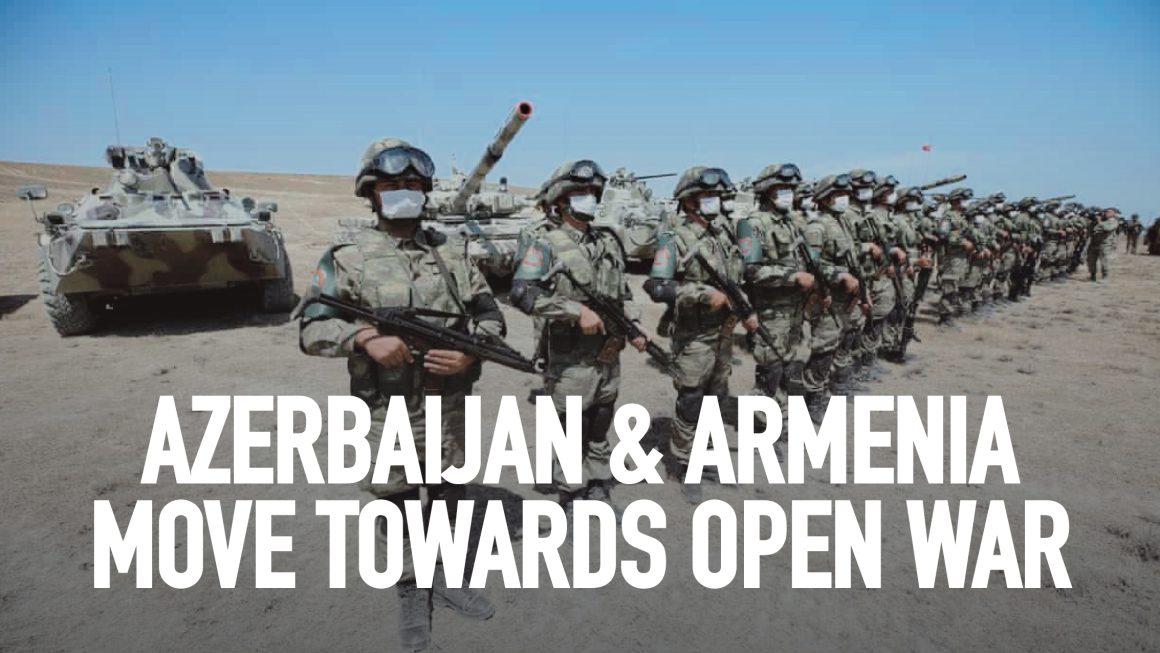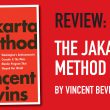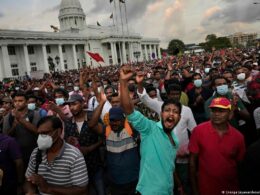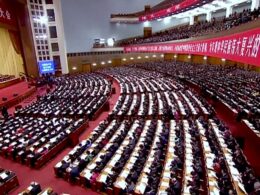Rob Jones, Sotsialisticheskaya Alternativa — ISA in Russia
War has once again broken out on the territory of the former Soviet Union. A long-term unresolved argument over the Armenian enclave of Nagorno-Karabakh between the Caucasian republics of Armenia and Azerbaijan has escalated into a conflict, in which Russia and Turkey are backing different sides. This is all taking place with the stench of oil in the air.
Over the last few days, Nagorno-Karabakh and its capital Stepanakert as well as parts of Azerbaijan and Armenia themselves have suffered heavy fighting with the widespread use of artillery. Tanks have been destroyed and aircraft shot down while claims and reports by each side indicate that the number of soldiers killed now reaches into the hundreds. Civilians, including children, have died.
A military situation has been declared in Nagorno-Karabakh itself and in several regions of Azerbaijan, whilst a general mobilization and martial law has been declared in Armenia. Iran complains that some artillery shells have been landing on its territory, while Armenia claims that one of its aircraft was shot down by a Turkish fighter.
Conflict rooted in 19th Century imperialism
Many commentators explain the conflict as due to a deep-seated hatred between the Christian Armenians and Turkish Azerbaijanis. It is true, of course, that the Caucasian region is a jigsaw of nationalities and religions. Since the collapse of the Soviet Union, it has been the scene of many conflicts including two horrific Chechen wars, civil war in Georgia, the Russo-Georgian war of 2008 and the 1991–4 war over Nagorno-Karabakh, which cost at least 20,000 lives and has since remained unresolved.
Many of these conflicts have a history in the divisions sown in the period before the Russian revolution, when the region was the focus of an intense conflict between the imperialist powers, including Britain, Russia and Turkey. This period left deep scars across the region, particularly the mass elimination of Armenians by the Turkish regime in the period starting in 1915 which left 1,5 million dead, only recently recognised as genocide by governments such as the US, which did not want to upset its relations with Turkey.
The Russian revolution offered hope for a better future. Initially, the overwhelmingly Armenian population of Nagorno-Karabakh chose to remain as part of Armenia which the Bolsheviks agreed to, this plan was upset by the Stalinist bureaucracy who, in order to appease Turkey and ease administration of the region transferred Nagorno-Karabakh into Azerbaijani control. Like many other parts of the Caucasus, Nagorno-Karabakh suffered from the criminal policies of Stalinism, these included forced collectivization and the deportation of ethnic Kurds from Armenia to appease Turkey in the 1930s. Over 100,000 Azerbaijanis were expelled from Yerevan following 1945 for fear they would become a “fifth column” if Turkey chose to invade. Overall, however, following the war the region developed economically thanks to the advantages of the planned economy.
Gorbachev’s perestroika unleashed national conflict
As the Soviet Union began to break up in the late 1980s however, demonstrations broke out in Armenia’s capital. Over environmental issues, against leaks from the local chemical plant and the presence of a nuclear power station in a seismically active zone they were initially ignored by Gorbachev. But when he sent troops, he provoked mass opposition and strikes, which then turned into the demand for the return of Nagorno-Karabakh to Armenia. As one student at the time said: “The national question is not the reason for the protests, but the excuse: we are against all oppression”. As the movement spread to Stepanakert, the local communist authorities, part of the Azerbaijan party leadership organized pogroms against the Armenian population, a brutal ethnic conflict broke out leading to dozens of deaths and then war between the two new countries. Over half a million Azerbaijanis were forced from Nagorno-Karabakh itself and some areas surrounding it. Despite a ceasefire in 1994, the conflict has not been resolved and for a short period in 2016 blew up again resulting in fatalities.
The new outburst of military conflict is not accidental, but a result of the global crises currently affecting the world, the growing conflicts between the imperialist powers, the escalating global economic crisis and the inability of the bourgeois elite to resolve the historical injustices in a way acceptable to all sides.
The Caucasian coronavirus crisis
With a joint population of just 13 million, the two countries have registered about 100,000 cases of coronavirus. Naturally this puts much pressure on the two governments.
In Armenia, despite the lockdown, the Central Bank believes that GDP will have dropped by 6% by the end of this year, even though the government has announced a stimulus programme based on one hundred construction projects. The bank does not expect the economy to recover until 2023.
Nikol Pashinyan, Armenia’s Prime Minister presents himself as a pragmatist who came to power as a result of the velvet revolution two years ago. His party fought the previous election on a pro-European platform but since coming to power he has followed a line friendly to Russia. He has no problems with Russian military bases in Armenia, which, he says, help to protect the Turkish-Armenian border.
Azerbaijan is, in contrast, an oil rich and openly authoritarian country. In line with the drop in global oil price, the price of Azeri oil has fallen to a third of its previous value during the pandemic. It is expected that the country will see a 4% drop in GDP this year, despite the government spending 3% of its GDP in a stimulus package. A similar drop in oil prices was a precursor to the short conflict with Armenia in 2016.
Until recently the Aliyev government has argued that it would like to improve living standards, but as long as there was the need to defend the country from Armenia, there were no spare resources. He maintains his power, in part, by creating a state of fear about the possibility of a new war.
July’s fighting
Tensions between the two governments spilt over in July as fighting broke out on the border between the two countries. Using artillery and drones about twenty people lost their lives, including high ranking military officers on both sides. According to PGI, a Security consultancy, both sides in this conflict were “primarily aimed at distracting domestic audiences critical of each government’s handling of the coronavirus (COVID-19) crisis rather than at provoking a military escalation”. It argued that this fighting, which took place 300 kilometers away from Nagorno-Karabakh would be limited, as both sides feared it would affect energy supplies. The area then affected was just walking distance from Azerbaijan’s main pipelines to Turkey whilst the Azerbaijan government threatened it would attack Armenia’s nuclear power station.
The ruling elite in both countries certainly used the situation to divert attention from their own failures, particularly during the pandemic. In Azerbaijani’s capital Baku large and vocal pro-war demonstrations were encouraged. Free speech is particularly restricted in Azerbaijan, where people are often afraid to speak openly in their own homes. Yet the regime has no problem allowing public calls to be made “for occupied lands to be liberated” or to “kill Armenians”.
Baku had hoped that when Pashinyan came to power in Yerevan, the Armenian position would soften as the previous government had been seen as close to the “Karabakh party”. Pashinyan soon destroyed that hope when he started stating publically that “Karabakh is Armenian land” and that “Armenia has no land to give away”. The Armenian authorities too have been whipping up jingoistic moods.
Peace talks rejected
The land-locked and mainly mountainous Nagorno-Karabakh may appear to be far from the centre of global politics but it is now the scene of a developing proxy war between imperialist powers. Russia has long treated the region as its back-door. It has tried to balance between the ruling elite of the two countries and has been selling weapons actively to both sides, more to Azerbaijan as it has more oil money to pay for the purchases. It has proposed mediating peace talks between the two sides but neither as yet trusts their northern neighbor. Azerbaijan, because Armenia has a mutual defense pact with Russia as well as large Russian military bases. Pashinyan, in his turn, has promptly rejected Russia’s proposal arguing that talks are impossible when there is such intensive fighting.
Russia’s motivation for brokering a peace deal is in part because it cannot afford another open military conflict in the Causasus when it is already facing a new dramatic economic crisis, a rapidly escalating second wave of Coronavirus and trouble in Belarus and its own eastern regions. But it also fears the growing influence of Turkey in the region. If Turkey is to forge a stronger alliance with Azerbaijan, and Russia loses its influence in Belarus, Russia will in effect not have any ‘friendly’ states all the way down its Western/South Western border from Lithuania, through Belarus and Ukraine to Georgia and Azerbaijan.
Turkey has certainly been upping the stakes since the conflict in July. It has had an on-off relationship with Russia since the collapse of the USSR, probably reaching a low point in 2015 when Turkish fighters shot down a Russian aircraft close to the Turkish-Syrian border. This led to a period of sanctions by Russia against Turkey, but intensive diplomatic efforts have since led to a significant improvement in relations.
Turkey and Russia: on-off relations
However, whilst the two countries maintain a friendly face when dealing with each other, and are prepared to support each other against the US, in many other ways their interests are in direct conflict. In the Middle East, they have found themselves on opposing sides of the conflict. in Syria Russia has supported the Assad government, whilst Turkey has supported the opposition, in Libya the situation is reversed. In part this explains why Armenia is bitterly complaining that Turkey is recruiting mercenaries from Syria to fight in Azerbaijan, while Baku responds by alleging that Yerevan is using PKK fighters.
Turkey is facing increasing economic problems, made worse by the coronavirus. Erdogan’s response is to step up repression and wage a ‘patriotic’ campaign suggesting Turkey is strengthening its influence abroad.
Azerbaijan, with its overwhelmingly Muslim population and Turkic language is seen as a natural ally, indeed some Turkish government figures talk of “one people, two states”. But there are deeper reasons.
Turkish oil supplies under threat
In July Turkish officials grew worried as the fighting in the Azerbaijani Tovuz and Armenian Tavush regions came desperately close to key transportation and energy corridors. The Baku-Tbilisi — Ceyhan and South Caucasian pipelines not only supply Turkey with 20% of its gas supplies, they are an alternative source reducing the country’s reliance on Russian energy. Turkey’s strategic interest is to strengthen its position in Azerbaijan, so that it can negotiate with Moscow from a stronger position. Urgency has probably increased on this issue given the Kremlin’s attempts to ‘mediate’ in the East Mediterranean conflict with the Russian Navy conducting live fire exercises in the vicinity of Turkish seismic research vessels.
Iran has a common border with both countries and significant national minorities. Normally siding with Armenia, it most of all wants to maintain stability in the region for fear of disruption spreading into Iran itself. Under the Trump administration, as expressed by John Bolton in 2018, the US has been pushing Armenia to open its border with Azerbaijan and Turkey and close the one with Iran. Given Armenia’s historic fear of Turkey, this undoubtedly heightened Armenia’s feeling of insecurity.
Paradoxically one of Azerbaijan’s strongest allies is Israel, which leans on the republic as a counterbalance to Iran, Turkey and Russia but most importantly maintains strong trade ties. 40% of Israel’s oil comes from Azerbaijan and it, in return, purchases significant arms supplies.
Big oil
The other big players are, of course the US and EU, both of which have major interests in the region. Most Azerbaijani oil and gas is produced by the US/UK owned BP, whilst the US supports the South Caucasian pipeline. In a few weeks, the EU is due to start importing gas from the country as part of its diversification policy, to lessen its reliance on Russian supplies. This gas will flow through the Turkey’s East Mediterranean port of Ceyhan. Even though recent fighting has been close to the pipelines, this has not yet affected world oil prices as demand has fallen significantly due to the global economic collapse.
The ethnic conflicts that raged across the Caucasus during and after the collapse of the USSR were a reflection of deep-rooted differences, but they followed a period in which the different nationalities, religions and ethnic groups were able to live in relative harmony.
But as capitalism began to be restored in the region, the trigger for the renewal of conflicts was often to be found in the struggle between different sections of the ruling elite for control over the wealth and natural resources. Today is no different. Whether in authoritarian Baku or the liberal democratic Yerevan, the ruling elites are defending their power and privileges by whipping up militaristic moods and ethnic tensions, a conflict complicated by the intervention of the authoritarian regimes of Turkey and Russia and the greed of western oil and gas companies.
Stop the war
The war has to be stopped, that can only be done, not by relying on the intervention of imperialist ‘mediators’, who for thirty years have failed to resolve the conflict, but by the active mobilization of working people and youth in both countries in a powerful anti-war movement with demonstrations and strikes and the active solidarity of similar movements in Russia, Turkey and elsewhere. Foreign powers should have no right to intervene in the region.
In stopping the war, however, the causes of the war need to be removed. There should be no more squabbling by the ruling elite over how to rob the wealth and natural resources of the region. They, including the oil and gas fields and pipelines, should be taken into public ownership with a democratic planned economy used for the benefit of all the peoples of the region.
Governments of the region, whether ‘authoritarian’ or ‘democratic’ do not represent the interests of ordinary people. Mass parties of the working class, women, youth and other oppressed layers are needed to take political power into their own hands.
The division of workers and youth on national or ethnic lines has to stop. Independent trade unions, workers’ parties or defense committees to resist the war should be organized on the principle of ‘workers’ unity’ cutting across the attempts of the ruling elite to divide us. This would allow for genuine self-determination — the right of peoples to decide how they live without ethnic conflict or cleansing.
This all leads to the conclusion that the Caucasus should be freed from the exploitation, repression and conflict by ending capitalism and replacing it with a genuinely democratic socialist society in a voluntary federation of socialist states.












